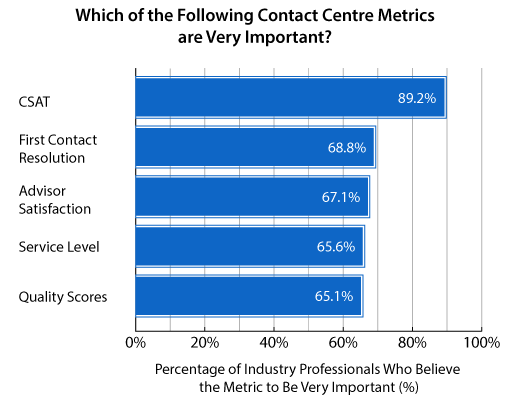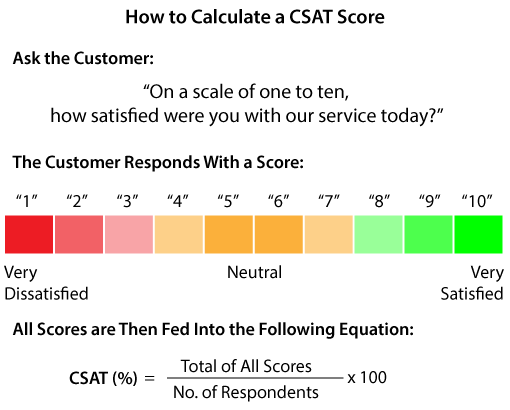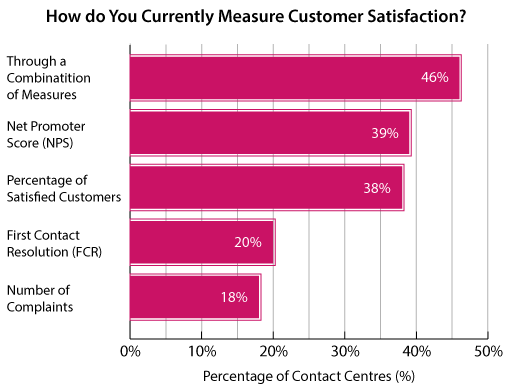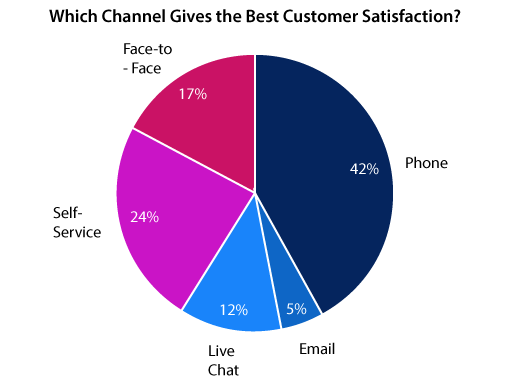7th May 2020

We define CSAT (Customer Satisfaction) before sharing how it can be measured and improved in the contact centre, for the benefit of the wider organization.
CSAT is a shortening of Customer Satisfaction.
CSAT is a simple measure of how a customer feels about your organization and is greatly influenced by the interaction with a contact centre advisor.
The reason why the metric is greatly influenced by advisor performance is because satisfaction is traditionally measured after a customer–advisor interaction.
While this is the conventional measure, CSAT can be measured in many different ways – at any point in the customer journey – whether that’s through surveys, customer focus groups or through social listening tools.
For this reason, it is difficult to compare CSAT scores across different organizations, but most will measure CSAT in some way or another.
According to our 2019 report: “What Are Contact Centres Doing Right Now?”, CSAT remains the “king” of contact centre metrics, with almost 90% of industry professionals seeing the metric as “very important”.
This was much higher than the second closest metric (First Contact Resolution), as is highlighted in the chart below.

The data that is shared in this chart comes from our report: “What Are Contact Centres Doing Right Now (2019 Edition)“
However, does this mean that we should all just start measuring customer satisfaction? Not necessarily. There are lots of things that we can measure.
We should use measures that help to drive the business and inform our understanding of the customer.
As Richard Kimber, Senior Manager at Comotion Consulting, says: “We should use measures that help to drive the business and inform our understanding of the customer.”
“On some level, it needs to be actionable, accessible to the people that can make a difference and auditable – which means that we understand where the data has come from and whether it can be trusted.”
From this, we can see that if we are to use CSAT as a measure in the contact centre, we need to have a strategy around it. Make it an organizational goal and not a contact centre-only goal. This will give you the best results.
When we want CSAT to improve across the organization everyone needs to know when and where CSAT is calculated and what they are responsible for.
CSAT is traditionally calculated using a post-call survey to calculate a score, which can be benchmarked over time, in order to assess the customer-facing impacts of organizational changes.
A classic way to do this is to ask the following question to a customer as part of a post-call IVR survey or a SMS survey: “On a scale of one to ten, how satisfied were you with our service today?”
Then you would find an average score, across your entire customer base, as to how satisfied your customers are.

While this gives you a good score to benchmark, a good view of CSAT at one customer touchpoint and an idea of who your satisfied and dissatisfied customers are, this method has plenty of drawbacks. These include:
Considering that measuring CSAT through finding the percentage of satisfied customers has each of these drawbacks, it was good to see that only 38% of contact centres are still doing it like this.

This poll was conducted during our webinar: Proven Techniques to Increase Customer Satisfaction
Surprisingly, the top response in this survey was “through a combination of measures”, suggesting that contact centres are becoming more sophisticated in their approach to measuring CSAT.
These measures will likely extend beyond the contact centre, so everyone becomes responsible for driving satisfaction – as organizations will hopefully look for less invasive ways for measuring CSAT than through surveys.
For more on how the contact centre industry can move beyond customer surveys and create better metric scores, listen to the following episode of The Contact Centre Podcast, with Morris Pentel, the Chairman of the Customer Experience Foundation.
The Contact Centre Podcast – Episode 11:
For more information on this podcast visit Podcast: Is It Time to Rethink Your Call Centre Metrics?
To discover the various ways that CSAT is measured, read our article: How to Calculate a Customer Satisfaction Score (CSAT)
A key point of this article has been to highlight that customer satisfaction extends well beyond the contact centre. However, we can still use CSAT to assess the effectiveness of our internal contact centre processes and systems.
Also, we can use CSAT to find which channels are proving most successful in driving good CSAT scores – generally, this does still tend to be the phone, as highlighted in our findings below.

This poll was conducted during our webinar: Proven Techniques to Increase Customer Satisfaction
But what some organizations may do to improve CSAT is to break this down further. They will look at which channel is best for different contact reasons.
With this insight, they can use their website navigation and proactive communications to nudge customers towards the channel that proves best – according to CSAT results – for handling that query. This can be a great way to improve your channel shift strategy.
This is just one way to use CSAT scores in the contact centre. Others include:
From many of these uses we can see that CSAT is a great tool for internal benchmarking, but – as it is measured in so many different ways – external benchmarking is not so insightful.
For more information on benchmarking and better utilizing your CSAT scores, read our article: Contact Centre Benchmarking – How to Get More From Your Metrics
How you improve CSAT will depend, to a large extent, on how you measure it. So, if you measure primarily through a Net Promoter Score (NPS) score, here is some great advice: 16 Ways to Improve Your Net Promoter Score
However, if you use a percentage of satisfied customers measure as your CSAT metric, or are looking for general ways to improve CSAT in the contact centre, here are four key areas to focus on:
1. Advisor Empowerment – If your advisors feel they have a large amount of control over their working lives, they will more likely feel that they can reach their full potential. This is empowerment, and when advisors feel like this, customer service improves – which can make a big difference to your CSAT scores, particularly if CSAT is primarily measured in the contact centre.
2. Effort – Following business models like Amazon, many organizations try to achieve “silent service”. This is where they take an organization-wide approach that the best way to improve CSAT is to remove problems, so customers have no need to call into the contact centre, where CSAT has the potential to drop.
The best way to improve CSAT is to remove problems, so customers have no need to call into the contact centre, where CSAT has the potential to drop.
3. Customer Experience – A good customer experience is impacted by a number of things, but if we can look for non-invasive CSAT insights at every key step of the customer journey, we can see where the greatest CSAT gains can be made. We can then also add rewards at certain touchpoints, where we can most positively influence customer emotion.
4. Customer Expectations – With leading brands becoming so difficult to deal with, customers have higher expectations of your brand than they previously might have. If you do not meet these expectations, achieving good CSAT results will be tricky – so managing and exceeding expectations is becoming an increasingly important task.
As these four fundamentals of improving CSAT are so important, we listed our advice for improving in each of these areas below.
We have compiled five quick tips for each of the four key areas above, with great insight into how to improve your CSAT scores.
To improve CSAT by increasing advisor empowerment, try out these ideas:
For more tips like this for improving advisor empowerment, read our article: What Does Employee Empowerment REALLY Mean?
To improve CSAT by lowering customer effort, try out these ideas:
For more helpful advice on reducing customer effort to boost CSAT, read our article: 7 Ideas for Lowering Customer Effort
To improve CSAT by improving customer experience, try out these ideas:
For more tips and strategies for enhancing customer experience, read our article: Improve Customer Experience: 5 Strategies That You NEED to Try
To improve CSAT by exceeding customer expectations, try out these ideas:

To find out the key to putting together a great card like this, read our article: How to Write a Customer Apology Letter – With an Example
For more tips like this on managing and surpassing expectations, read our article: Top 10 Tips for Exceeding Customer Expectations
CSAT is a measure of how satisfied your customers are and is therefore a metric of how your customers feel – that is the fundamental CSAT meaning.
There is, however, no one “industry standard” way for calculating CSAT. In fact, most contact centres now use a combination of measures.
Yet having one central metric is still beneficial, as we can benchmark, test our process changes and closely analyse the customer experience.
To put it simply, you can use CSAT to test how happy your customers are. So if you’re looking to increase your CSAT scores further, we hope that the 20 tips provided in this article will provide you with some great guidance.
Good luck!
For more on using and improving CSAT in the contact centre, read our articles:
Reviewed by: Megan Jones